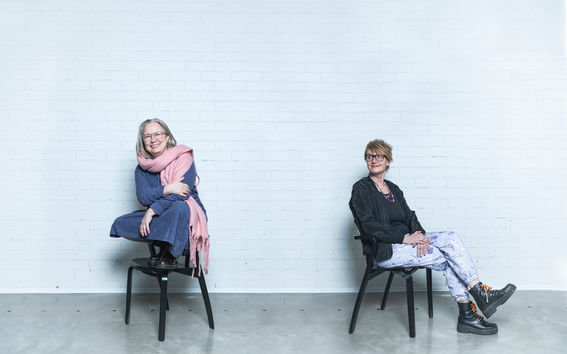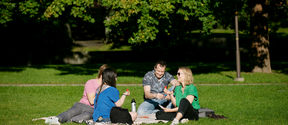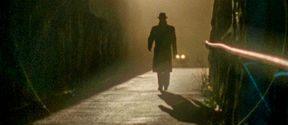Sotera
SOTERA is the research group for Health and Wellbeing Architecture within the Department of Architecture at Aalto University. Our work supports Aalto University’s focus areas of Health and Wellbeing and Human-centred living environments.

What does art have to do with health and social services? More than one might expect. Professor Susanna Helke makes documentary films, the latest of which uses cinematic art to highlight the crisis in care work. Professor Laura Arpiainen’s speciality is architecture that promotes health and wellbeing. At their very heart, architecture and the design of the built environment have inclusivity and user-centeredness, and aim for equitable design that considers all user groups.
Although Helke and Arpiainen practice different artistic disciplines, they share a desire to change the health and social sector and improve general wellbeing. ‘We’re concerned that the Finnish Health and Social Services Reform has been predominantly planned from an administrative perspective. We’ve both thought a lot about what the system does to people,’ says Arpiainen.
Arpiainen’s project for integrated diverse living solutions for people with memory decline, known in Finnish as MonIA, ended last autumn. The project consortium included government representatives, municipalities, private and public sector developers, and service providers.
Helke’s film Ruthless Times – Songs of Care is a choral documentary about issues in care for the elderly. The film was part of a project called Images of Harmony and Rupture, which explored documentary film as a reflection of fractures in the welfare state. ‘The point was to show the total incompatibility between the logic of money and the production of intangible value,’ says Helke.
How can art and artistic research change society? ‘We can do it by telling the truth, asking tough questions and presenting strong opinions. That’s social activism, and that’s what we are doing here at the university – changing the world,’ says Arpiainen.
Her argument is that as artistic disciplines, both architecture and cinema can deeply affect viewers because they communicate something that cannot be described in words or through other means. ‘We can make all the complaints we like about the problems of care for the elderly, but when Susanna creates a film about the subject, it speaks to you on a different level. It’s a powerful way to get the message across.’
Art and artistic research challenge prevailing ways of thinking. Arpiainen and Helke argue that the situation known as a sustainability deficit is, in fact, partly due to the fact that society has succeeded at something: extending people’s lifespans. But this creates a paradox when elderly people are seen exclusively as an economic burden.
According to Helke, the power of documentary film lies in its capacity to make things visible. Instead of presenting an action plan, cinema offers knowledge in an emotional, embodied and experiential form.
‘The language of economics is the violent mumblings of technocrats,’ says Helke. ‘By showing a bunch of old people in a remote landscape singing that they are the sustainability deficit, the film carnivalizes political discourse and illustrates the power of language through black humour. Some generations are condemned to live that discourse. Still alive? Oh, you should have died years ago. There’s no room for you in the budget.’
Architectural design can also challenge prevailing ideas about care. Arpiainen explains that the design of the built environment rarely takes into account human realities. For example, people with Alzheimer’s shouldn’t be isolated from the rest of society. Instead of an impersonal clinical institution, they need memory anchors around them: familiar buildings, works of art, landmarks and, above all, community.
‘A bench you know from before can bring back a memory of sitting on it with your father when you were five. You can’t just casually raze the urban environment. You must preserve elements that have been there for a long time,’ she says.
The living environment should be intuitive and accessible so people can live independently for as long as possible. For example, acoustics plays a surprisingly important part in the wellbeing of people with memory disorders: hearing aids can produce echoes, and noise can be distressing and cause an already vulnerable person to withdraw.
Professors Helke and Arpiainen have worked extensively with social and health professionals and administrators. Part of this work is bridging the languages used by health and social care professionals and experts of artistic disciplines.
Arpiainen hopes that mutual understanding has increased. Her collaborators have been surprised at the depth of meaning embedded in every detail of architectural design.
She recalls a studio course for designing a huge community health centre. The crucial underlying issue was never expressed: namely, whether there was any point in building such a massive unit. Care professionals also found it hard to understand some design choices. For instance, white walls are such a well-established ‘clean and sterile’ solution that people are often oblivious to alternatives.
‘It’s easy to talk using their own terminology, like “this allows you to combine procedures more efficiently,” but if you design a purple room, that’s sure to raise eyebrows. We also tried to break up corridors so that the space would be more than just long tunnels with numbered doors,’ she says.
Helke’s film turns a critical gaze towards a company providing health services and on experts advocating digitalisation. But since she hasn’t received direct feedback from either party, she has no idea what their reaction to the collaboration has been.
The criticism in the film is expressed through subtle contrasts, parallels and personal reactions. An encounter between a person with memory decline and a care robot appears absurd. The film also asks whether a poor municipality benefits from outsourcing its health and social services – which are paid for with tax revenues – if in the process it loses control over cost increases.
‘I don’t see why anyone should have the opportunity to make a profit from health care,’ says Helke.
But Arpiainen is not quite as critical of the market economy. ‘Competitive bidding or outsourcing may be useful, but outright profiteering certainly isn’t. There are different models of health care, but they must all be human-centred. Nobody wants to be just a number abandoned in a tiny room, wrapped in plastic sheets,’ she says.
Helke has had the opportunity to talk with political influencers and experts. She hopes that experiencing the film has generated a common understanding, even if only for a fleeting moment. Her meetings have given her a sense that something might be moving forward.
Although the film has won awards at festivals, the biggest reward for Helke comes in the form of encounters with the audience. ‘Some people have come to thank me with tears in their eyes or to tell me how they’ve had to provide terminal care for their own mother, and it pains them how things turned out. The film validated their experiences.’
Laura ArpiainenCompetitive bidding or outsourcing may be useful, but outright profiteering certainly isn’t. There are different models of health care, but they must all be human-centred. Nobody wants to be just a number abandoned in a tiny room, wrapped in plastic sheets.
Text: Terhi Hautamäki
Photo: Jaakko Kahilaniemi
This article has been published in the Aalto University Magazine issue 32, April 2023.

SOTERA is the research group for Health and Wellbeing Architecture within the Department of Architecture at Aalto University. Our work supports Aalto University’s focus areas of Health and Wellbeing and Human-centred living environments.

The Lab hosts a project Images of Harmony and Rupture - Documentary Film Reflecting Fractures in the Scandinavian Welfare State Ethos. It is funded by the Kone Foundation and headed by
Professor Susanna Helke. DAs Jouko Aaltonen and Timo Korhonen work as postdoctoral researchers.



